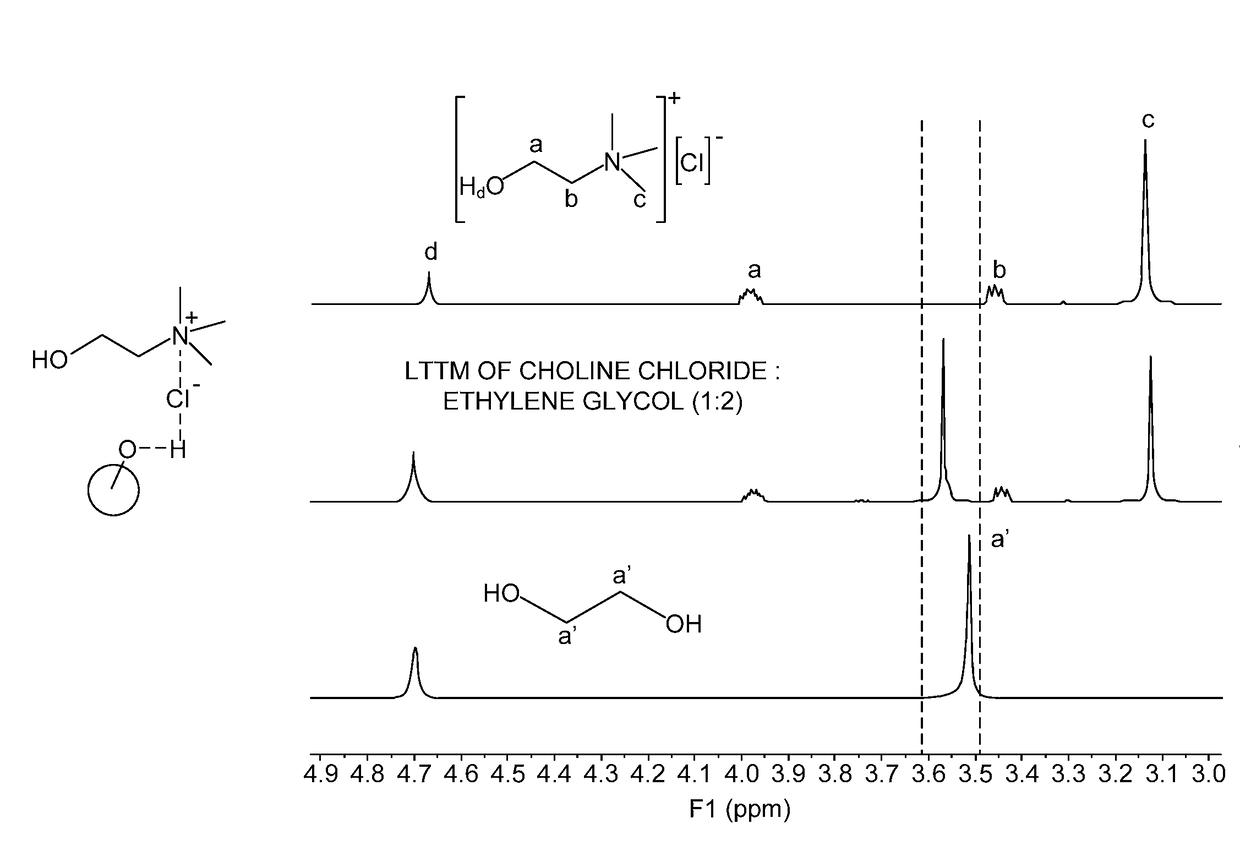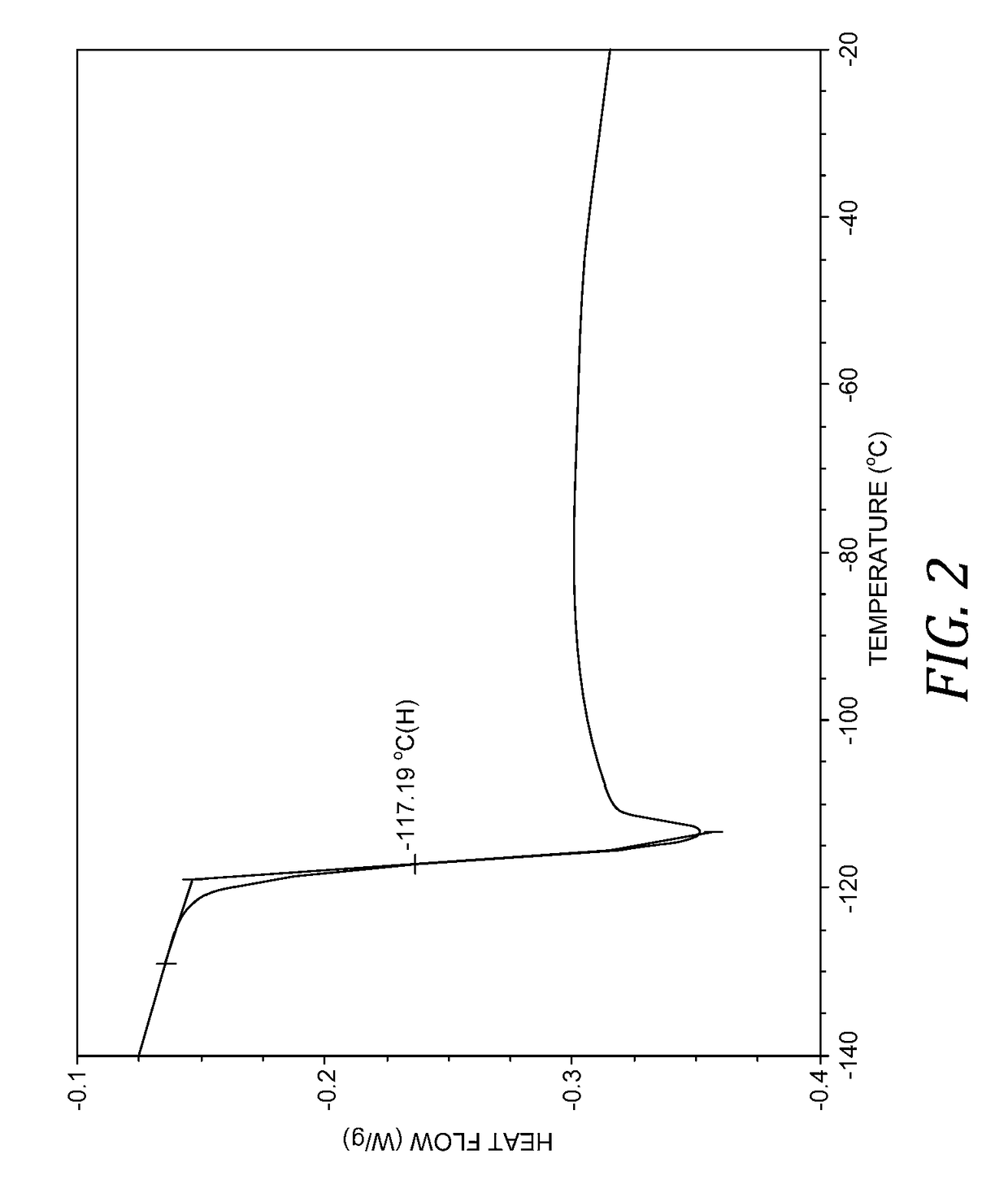Low Transition Temperature Mixtures and Lubricating Oils Containing the Same
a technology of low transition temperature and lubricating oil, which is applied in the direction of lubricant composition, petroleum industry, base materials, etc., can solve the problems of limited range of available raw materials, difficulty in achieving high purity, and high cost, and achieve low glass transition temperature, high viscosity index, and low traction coefficient
- Summary
- Abstract
- Description
- Claims
- Application Information
AI Technical Summary
Benefits of technology
Problems solved by technology
Method used
Image
Examples
example a
Overview of Lubricant Properties of LTTM Fluids
[0091]Table 2 shows compositions and properties for a series of inventive LTTM fluids and comparative materials. The molar ratio is that of the first component to the second component. In comparative Example 11, a LTTM was not formed at the specified molar ratio between the first and the second component. In Example 14, the composition further comprises water at about 2 wt %, based on the total weight of the composition of the LTTM. Details of the LTTM fluids in Table 2 are further described in the following examples. In comparative Example 15, a commercial polyalpha-olefin base stock (PAO5) is provided as a reference material for the LTTMs with similar KV40, KV100, and VI.
TABLE 2PropertiesCompositionVis-Exam-FirstSecondcos-pleCompo-Compo-MolarKV100KV40ityTgNo.nentnentratio(cSt)(cSt)Index(° C.)1CCEG1:25.2722.67177.1−117.192CCEG1:43.3113.13125.03CCEG1:52.9811.81104.6−119.594CCEG1:62.8011.1092.05CCEG1:92.5310.1861.7−118.996CCPropyl-1:44.6...
examples 1-5
Preparation of CC / EG LTTMs
[0093]Examples 1-5 correspond to LTTMs formed from CC and EG in molar ratios of 1:2, 1:4, 1:5, 1:6, and 1:9, respectively. It was observed that an LTTM did not form when CC and EG were mixed in a 1:1 ratio. The CC / EG LTTMs generally showed high VI values, and in particular, Example 1 shows a VI in the range from 170 to 180, which is exceptionally high. This high VI value is exceptionally high when considering the viscosity of the LTTM in Example 1. Example 15 shows an example of a commercial polyalpha-olefin synthetic base stock having a VI in the range from 130 to 140. More generally, in spite of the low molecular weight of the components, the LTTMs of Examples 1 to 5 all had KV100 in the range from 2.0 to 6.0 cSt and VI's of at least 60. For Examples 1, 3, and 5, the glass transition temperatures were lower than −110° C.
[0094]To form the LTTMs, 40 mmol (5.58 grams) CC and EG (80 mmol (4.97 grams), 160 mmol (9.94 grams), 200 mmol (12.43 grams), 240 mmol (1...
example 6
Preparation of CC / Propylene Glycol LTTM
[0096]Example 6 corresponds to an LTTM formed from CC and propylene glycol (HO—CH2CH2CH2OH) (MW 76.09, mp: −59° C.) in a molar ratio of 1:4. The CC / propylene glycol LTTM showed a VI of at least 70 and a KV100 in the range from 4.0 to 5.0 cSt. The glass transition temperature was lower than −100° C., as shown in the DSC diagram in FIG. 5.
[0097]To form the LTTM, 40 mmol (5.58 grams) of CC and 160 mmol (12.17 grams) of propylene glycol were added to a 50 mL round-bottom flask. The components were heated to 70-80° C. while stirring until a homogenous liquid was formed.
PUM
| Property | Measurement | Unit |
|---|---|---|
| kinematic viscosity | aaaaa | aaaaa |
| glass transition temperature | aaaaa | aaaaa |
| glass transition temperature | aaaaa | aaaaa |
Abstract
Description
Claims
Application Information
 Login to View More
Login to View More - R&D Engineer
- R&D Manager
- IP Professional
- Industry Leading Data Capabilities
- Powerful AI technology
- Patent DNA Extraction
Browse by: Latest US Patents, China's latest patents, Technical Efficacy Thesaurus, Application Domain, Technology Topic, Popular Technical Reports.
© 2024 PatSnap. All rights reserved.Legal|Privacy policy|Modern Slavery Act Transparency Statement|Sitemap|About US| Contact US: help@patsnap.com










